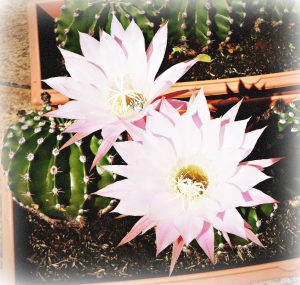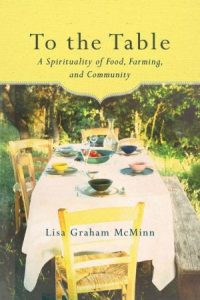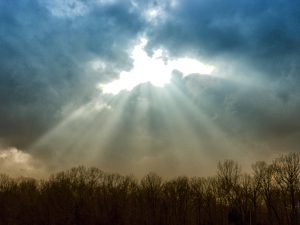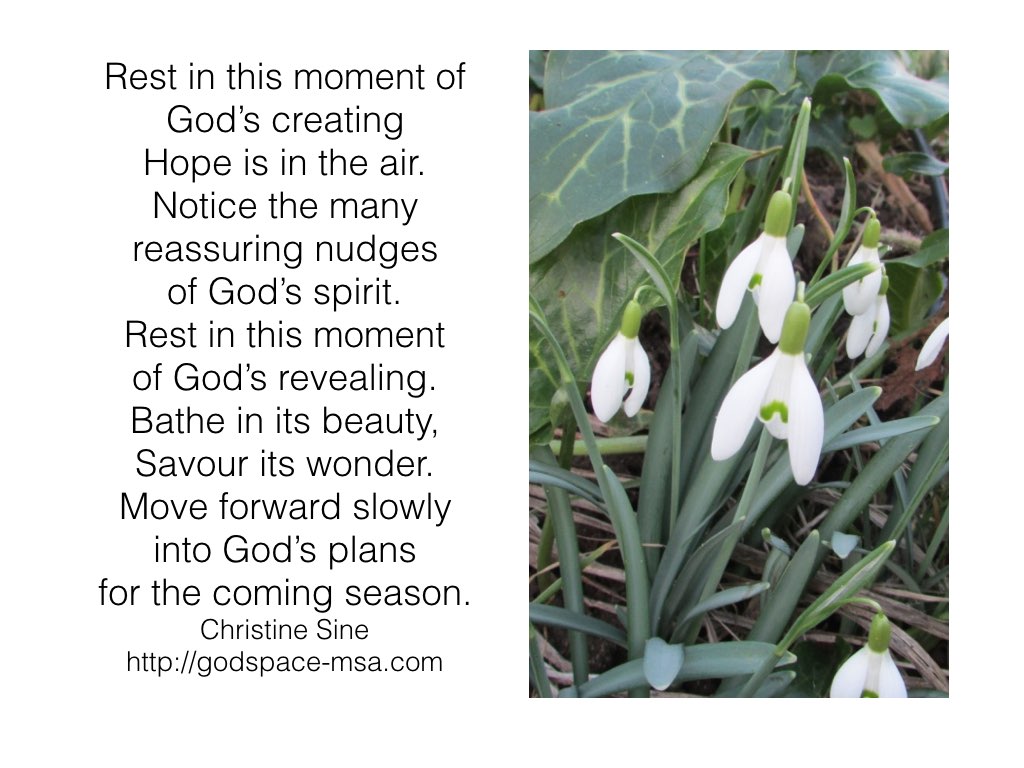By Joy Lenton
As we continue to ponder the wonder of the resurrection of Jesus and His release from death’s steely grip, we would love our own mini-resurrections as such to be just as sudden, miraculous and breathtaking.
For the healing to be spontaneous, pain to disappear, long held hopes to be met and dreams to come true. Because sitting within the dark soil of our thorny, intractable situations, we long for release, new life to burst forth and bloom brightly.
But what if faith and change look more like a long walk of obedience in the same direction? What if simply showing up and saying a daily yes to God could precipitate alteration and heavenly celebration?
We say it is good to let go and let God, while many of us actually want Him to loose us from the chains of daily captivity – from a life-less-ordinary, unwanted circumstances, overly busy schedules, the stress and strain of our earthly existence.
In the letting go we are actually still rooted in reality, but the difference is we are trusting God for outcomes we cannot see. It’s not a resignation, a careless giving up or a turning away from those challenges. It’s a heart’s moment by moment decision to loose the hours and the future into God’s hands, to choose to trust where we cannot see, to decide to yield to His will and ways for our lives.
It’s letting our cares and concerns be looked after by our Burden-Bearer, allowing our own perceived control to go, to release stress, strain and pain to the One who gives us His perfect peace right in the midst of life’s muddles and mess.
And in the unloosing, we discover how it begins to make us free on the inside. Resurrection hope means that real freedom lies in a surrendered heart and life. Externally, life may go on as before but we are able to see things from a fresh perspective, have hope renewed, sense relief and feel at peace as our souls rejoice in the giving over to God.
Living in liberty
Sinking again into the darkness
of our self-inflicted tombs,
we often fail to see or sense God’s
presence within. He waits with patient
tenderness and deep willingness
to roll away those confining stones
which seal our hope and prevent
us living in His Light and liberty.
All God asks of us is a willing yes
as He works diligently to remove
one obstacle after another, to reveal
His great grace and unfailing desire
to be our soul’s first, true Lover,
dearest friend, guide and brother.
©JoyLenton2016
Is it easy? By no means. We lean toward God’s light while our wayward hearts tug us toward the accustomed darkness. It’s a decisive stretch in His direction, a matter of mind over matter and a wobbly walk of faith that leads to our souls rising strong.
My own heart has been down dark pathways recently as inexplicable discouragement sat heavy within. Life is so often not what we want it to be. There has been a real inner tussle and a painful deliberation to pursue peace and joy when it all seems so elusive.
But I urge you to keep looking toward the light of God’s countenance, keep pursuing Jesus for all you are worth and fight for your faith when it feels like everything around you is trying to pull you away from it.
We have our struggles because we live in a fallen world and in the here-but-not-fully-here-yet Kingdom where the enemy seeks to push us to our knees – and that’s in despair rather than prayer.
Yet we see glimpses of grace whenever we look for them. We see life and truth and beauty. We see joy in the midst of pain and hope nibbling at the edges of despair.
So if these post-Easter weeks have left you depleted, lift your weary head and remember this – God loves you so very much; you will be sustained, given strength to live with life’s challenges, hope to replace sadness, unexpected joy in dark places, and grace upon grace to become eternally whole as you are being renewed from the inside out.
by Christine Sine
I have just finished reading Lisa Graham McMinn’s new book To the Table: A Spirituality of Food, Farming and Community. This is a book well worth reading. Through the telling of stories, the sharing of recipes and the relating of her own personal journey from college professor to CSA owner, Lisa encourages us to head for our gardens, farmers markets and dining tables to learn to eat more intentionally and more prayerfully.
As a person who loves both gardening and hospitality, this book really spoke to me. It made me realize how much more I have to learn though. It is well researched and provides a rich foundation of facts about food and the systems that produce it. With its plethora of well thought out questions and reflections it is ideal for small groups, bible studies and personal reading.
My favourite quote:
Reflecting God’s image in the kitchen requires us to stop thinking about food only as body fuel and see it as one of God’s primary ways to express divine provision. And we can’t make the trade without a reverence for creation….. If food is one of God’s most abiding and daily love languages, then preparing food puts us smack dab in the center of a deeply spiritual and physical process that begins and ends in the arms of God. Once we see food as God’s loving, tangible provision, we find it in snap peas, in the freezer, the onions in the cellar, and the barley in the pantry. Working with tangible expressions of god’s love becomes holy work, good work. (pp 45, 46)
By Andy Wade –
How terrible it will be for people who call good things bad and bad things good,
who think darkness is light and light is darkness, who think sour is sweet and sweet is sour.
Isaiah 5:20 (New Century Version)
It’s easy to become overwhelmed by the chaos and confusion swirling around us. Before we realize it, we’re caught up in an emotional whirlwind. Oftentimes this whirlwind is filled with misperceptions that lead us into thinking that good is bad, and bad is good.
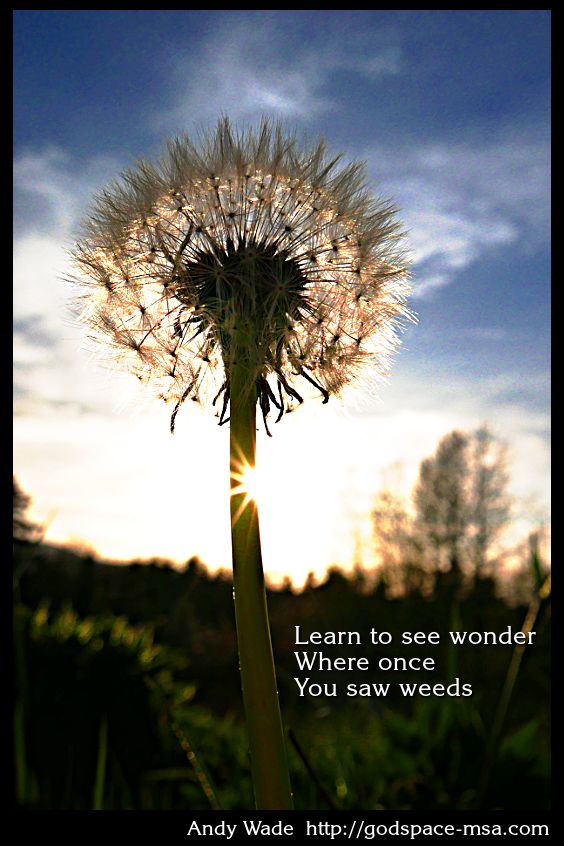 This can happen in our community as we strive for connected lives and flourishing neighborhoods. We encounter a problem in our community that needs to be addressed. That problem – you know what it is where you live – is causing tension and turmoil. Something has to be done!
This can happen in our community as we strive for connected lives and flourishing neighborhoods. We encounter a problem in our community that needs to be addressed. That problem – you know what it is where you live – is causing tension and turmoil. Something has to be done!
Scratching below the surface, we discover the problem is simply a symptom of some deeper issue. And at the root of that issue we usually find people. This is where we need to focus. The creative potential of individuals and groups applied in destructive or divisive ways can manifest as major difficulties in the community. When we simply react to symptoms we fail to see where the image of God is present in the people involved. In our rush to address symptoms we easily discount, even demonize, the people behind them. When this happens, our reaction to the symptoms easily results in crushing the spark of God’s divine presence in those involved and, more often than not, results in the symptoms popping up in other forms.
Until we can slow down enough to untangle the person, the imago dei, from the issues, we risk snuffing out the “smoldering wick” in others while at the same time betraying our call as “ambassadors of reconciliation”.
There’s a weed in our yard, it’s called purslane. Although its roots are not deep, it spreads. In a fit of frustration I yank it out by its roots and, by all appearances, I’ve dealt with the problem. What I fail to realize is that, as I pulled it out, it broadcasts its seeds even further. But here’s the thing: like the dandelion in the photo above, purslane is one of the most nutritious greens in the garden!
Purslane may be a common plant, but it is uncommonly good for you. It tops the list of plants high in vitamin E and an essential omega-3 fatty acid called alpha-linolenic acid (ALA). Purslane provides six times more vitamin E than spinach and seven times more beta carotene than carrots. It’s also rich in vitamin C, magnesium, riboflavin, potassium and phosphorus.
Mother Earth News
There is a lesson in all of this, perhaps several lessons. But the one that captivates my imagination is that, in my pragmatic approach to life I can easily lose the wonder. To sit in my yard, or my neighborhood, to just sit and take it all in and marvel at its wonders, here is the beginning of wisdom. God is already present. God is already at work. Even in the most unlikely people and circumstances, God is here.
And here is my challenge for the week: Find a place where you can sit and listen, watch, and wonder.
- How might God be present even in places and people you thought were devoid of the Spirit?
- How might God already be at work?
- What would it look like to enter into that person’s life, or that situation, in a way that embraces the image and touch of God just waiting to be revealed?
By Rowan Wyatt
Rising
See the clouds as they weave in wispiness
Bobbing and waving as curtains they part
Floating white fighting the wind to open wide
A heavenly gateway opened for the beloved.
Each gathered kneeling, standing, sitting
Ringing in a human halo around the master’s hand
In tears of wonder, love and joy, each tinged
With the sadness of a loved ones loss.
The morning glow of warmed sunshine rays
Catch the salted sheen of tears and with
Ancient holy alchemy turns them diamond shining
Each shed for the home bound Messiah.
And the heavenly host proclaim the time in fanfare
Loud as angels blast their horns in triumph
As the once dead son returns to his father
And leaving the saddened throng behind to work.
Then as the curtained clouds are drawn once more
The gathered faithful stand and stare above
“Why do you stand and look to the sky”? the angels ask
In gleaming robes of eddying white shimmer.
He will come again the same way you saw him go.

The Ascension by Catherine Andrews used with kind permission
Thinking about Ascension Day may conjure up thoughts of sadness. To imagine Jesus disappearing into the clouds and going far, far away! I think about the way the disciples may have felt seeing their Master Jesus for the last time, keeping their eyes fixed on him like the last rays of the sun, until they could no longer see him, and then the message from the angels.
In John 14-17 this beautiful passage of scripture carries the voice of Jesus into how we can hold the mystery of his ascension. He promised that although he needed to return to the Father, he would be going to prepare a place for each of us. He promised to be with us through the ages, and to never forsake us. And he promised to send the Holy Spirit as our ever present Friend, Counselor and Comforter.
I find myself with Thomas in the room, a spirit crushed with the recent events of Jesus’ terrible death. He did not want to have his hopes raised only to be bitterly disappointed once again. A very special interaction took place between Thomas and Jesus, with an invitation for Thomas place his hands into the very wounds that purchased our healing and life. And a message, Stop doubting, and believe. Blessed are those who have not seen, and yet believe. John 20:24-29.
I have heard of Jesus appearing to modern day people since the day of his Ascension and giving them special graces, messages and encounters of love. For some, it has been on their death bed as a near death experience, and they have then returned to continue the fulfillment of their lives’ purpose. They have seen Jesus and been transformed powerfully through having felt his unconditional love.
Others have encountered Jesus in dreams and visions of the night, that have led to incredible conversions, miracles of healing or prophetic words for the future.
I went through a time a few years ago when I started to really desire to see Jesus in the flesh. Knowing God has no favourites, I struggled to understand why it was I did not experience what I longed for. But I came to a real fellow feeling with Thomas, and felt as though he could be a close relation. Not looking down on him from some high place, scorning his lack of faith. And then the words came to me, blessed are those who have not seen and yet believe.
There is a special blessing Jesus promised for us, who do not see and yet believe. Our spirit is with Jesus in the heavenly places – though our earthly minds cannot get to grips with it, we experience it in walking our day to day relationship with Jesus in the spirit of faith. This faith is his gift, not something we conjure up or strive for.
The moments of light, when we know we are encountering God, are true gifts, but even when we don’t see or feel, we can be completely assured and at rest in the completed work of Jesus and his resurrection power. He is faithful to the end and will not falter, no matter how the world falters, no matter how frail we sometimes feel, he has promised to never forsake us and eternally be true to us. He is in us as we are in him. And the Father loves us with the same love he has for Jesus.
The cross is the turning point of history, and the resurrection seals every promise eternally. The Ascension is his way of showing us where to look and keep our gaze focussed while we are earth bound and yet spiritual citizens. Look up. Don’t look to the left or the right, hear God’s voice saying, This is my Beloved Son, whom I love, listen to him. Look up from the daily incidences, from where we stand, look up. Keep our spiritual eyes and frame postioned upward, for the Lord has promised, he is coming again and will return in the same way the disciples saw him leave.
We can be completely assured that Jesus lives for us today! He is seated on the throne beside his Father and our Father. He taught us how to pray, as children in a great family, part of, belonging. He lives to intercede for us and his love has no limit.
“And , when I am lifted up from the earth, I will draw all people to myself.” John 12:32
In which areas of your life is Jesus drawing you to himself?
“…I bore you on eagles’ wings, and brought you to myself.” Exodus 19:4
Though we may not always see with our human eyes, we can know in our spirits, he is King of kings and Lord of lords in the heavenly places, and yet he is here, right now, reaching out for you and for me.
“The same one who came down is the one who ascended higher than all the heavens, so that his rule might fill the entire universe.” Ephesians 4:10
Maranatha
You have gone ahead of us, Bright Morning Star
Song of Heaven, you passed through the gates
With the blood you poured out.
Every instrument played through your being
With the crescendo of souls now redeemed.
Maranatha Lord, we cry,
Come, come again.
The final goodbye on the mountains of earth,
With a last embrace you departed and your friends stood
Watching, as the soles of your feet blessed the sky.
Every word you spoke, each miracle
Every touch, laugh, tear and wound:
Left as a sign for the ones to follow.
All that cannot be seen is now more real
Than flesh on flesh or blood in the veins.
You have drawn me up into the Heavens with you
And you are calling me still.
Maranatha Lord, we cry,
Come, come again.
This post is out of date, please see our latest new version.
The day of Pentecost is June 4th this year and it is rapidly approaching. Each year I like to update my resource list with new and fresh ideas. I also like to write a new prayer each year that captures something of my own response to the day. The prayer above is from 2015 but has been the most popular of my Pentecost prayers. Here is my prayer for 2016.
As you can imagine my resource list grows longer each year. Enjoy this year’s update, share it with your friends and let me know if you have other creative ideas that should be added to the list.
This is the day when we celebrate:.
- The coming of the Holy Spirit and the infilling of Jesus’ disciples with the power to go out and change the world
- The great multi cultural gathering that we catch a glimpse of as we watch the spirit fall and suddenly everyone is able to understand each other – not all speaking the same language but able to understand each other in their own languages. Acts 2:11.
- Pentecost is traditionally the time that many churches pray for the peace of our world in which at times there seems to be so little cross cultural understanding.
So what kinds of resources do we need?
- First I think we need to provide our congregations with resources that help them see Jesus from other cultural perspectives. In a visual society like ours art is one very powerful way to do this. Matt Stone has one of the most comprehensive collection of links to Christian art around and is well worth visiting during Pentecost to remind yourself of the multicultural nature of Christ’s body.
- Liturgy is another powerful tool because as we read the words aloud they resonate deep within our souls and take root.
- Creativity should also be a large part of our observances – this is a time to think out of the box, to stir our imaginations and get inspired with ideas that can change the world. Last year I posted some of the most creative ideas I have come across in Let’s Get Creative with Pentecost. I particularly love the chili cookout!
This festival is known by several names in the Old Testament: the Feast of Harvest (Exodus 23:16), which represents the firstfruits (Numbers 28:26) gathered as the result of the labour of those who completed the spring grain harvests in ancient Israel (Exodus 23:16).
It is also called the Feast of Weeks (Exodus 34:22), derived from the seven weeks plus one day (50 days in all) counted to determine when to celebrate this festival (Leviticus 23:16). Similarly, in the New Testament, which was written in Greek, this festival is known as Pentecost ( Pentekostos in the original), which means “fiftieth” (W.E. Vine, Vine’s Complete Expository Dictionary of Old and New Testament Words , 1985, “Pentecost”). See The Feast of Pentecost for more information.
One practice for the feast of Pentecost was for the priest to wave two loaves of bread in the temple before God in thanksgiving for the early harvest. Though the Jews did not see the symbolism, the two loaves represented two groups of people God planned to harvest for His kingdom: His chosen people the Jews and everyone else called the Gentiles. This Sunday, for lunch after church or for dinner that night, you might buy two loaves of bread to imitate the original practice. Give thanks that God’s gift of redemption is for all who are willing to receive it. (From Ideas for Celebrating Pentecost)
Paul Neeley at Global Christian Worship has an excellent array of articles, liturgies and songs for pentecost.
Pentecost: True Spiritual Unity and Fellowship in The Holy Spirit
10 Global Pictures & Prayers for Pentecost
Pictures & Prayers of Pentecost
‘Pentecost’ by Shadow Play Puppets
African Pentekoste by Frombach & Lantz
Gina Tuck – ‘Hymn to the Holy Spirit
Pentecost Songs: An Entire Album! from Cardiphonia
Visual Tools
To get yourself in the mood watch this wonderful video from Africa – it immediately took me back to some of the beautiful worship services I attended in Ghana, Togo and Cote d’Ivore when I worked on the Mercy Ship Anastasis
Another of Paul Neeley’s links was to this beautiful song by Keith and Kristyn Getty but I loved it so much I wanted to incorporate it in the list.
I also a produced a video several years ago to help myself catch a glimpse of this multicultural image of Jesus.
From Australia & New Zealand
The Billabong has a great list of ideas for Pentecost. I particularly love this suggestion Kites for Pentecost.
Laughing Bird Liturgical Resources
From Bosco Peters in New Zealand
Matt Stone at Glocal Christianity still has the best collection of art from different cultural contexts.
And one of my favourites from Steve Taylor – a kiwi who now lives in Australia.
From South Africa
Sacredise.com always produces wonderful resources
From U.K
Jonny Baker always provides great resources in his worship tricks. You check out the general list for pentecost here.
I particularly like this link to a Pentecost meditation by Mark Berry.
And I love these pentecost prayers and this liturgy with a Celtic flavour by John Birch
Proost is a great U.K site for worship resources. Here is the link to Pentecost resources
And if you are looking for some fun food ideas for the day check these out.
From Canada
Re-worship always provides excellent resources and this Pentecost list is no exception
From U.S.
The Text This Week has some of the most comprehensive resource lists around. Their pentecost list is well worth visiting.
Proost resources are now also available in the U.S. Here is the link to Pentecost resources
From Lent and Beyond is an Episcopal site with more great resources. I was particularly appreciative of their link to this site for celebrating Pentecost with kids.
Christine Longhurst at re:Worship also lists hymns, readings, prayers and liturgies for the season.
And a great Pentecost liturgy from Work of the People
Another good list is Resources from the Calvin Institute
A beautiful Pentecost poem from Outside the Box
And for a short meditation I enjoyed this video by Franklyn Shaefer
Or if you are looking for an introduction to the season for kids this is hard to beat
Or this from Busted Halo
Godspace Resources:
I have written several other pentecost prayers in the past but the following litany is probably my favourite:
God, the light of your Spirit has fallen upon us,
The seal of your ownership is on us,
You have placed the Holy Spirit in our hearts.
Like tongues of fire it has renewed and restored.
In our rising and our sleeping,
In our working and our playing,
In our joys and in our sorrows,
Your Spirit’s brightness has dispelled the darkness,
In our loving and caring,
In our touching and our listening,
In our thoughts and in our actions,
God’s Spirit has brought life out of death.
Read the entire prayer here: A Prayer for Pentecost:
Living In Between Ascension and Pentecost
I have also been uploading Pentecost images on Facebook and Pinterest.
I love this season that surrounds Earth Day and my own personal focus on sustainability. I also find it challenging though, as so much of what I read is negative – climate change, hottest seasons on record, growing toxicity of our oceans and possible death of the Great Barrier Reef in Australia – all bring me to despair and make my heart ache. I feel so powerless, so inadequate and at times so hopeless. And digital world doesn’t help. The stories of environmental degradation are rampant. Lakes drying up in Africa, the strongest hurricanes on record, bee collapse, the list goes on – destructiveness not creativeness is highlighted.
Looking for signs of hope and finding them is not always easy. It needs to be a very intentional action. One that starts with a trust in the God of hope, in the God who is in the process of making all things new.
What gives me hope at this season? Last week I went looking for them and found some very encouraging examples. Churches like our own St Andrews Episcopal here in Seattle that is making a difference with solar power, stories like When I dream of a Planet in Recovery and people like Wendell Berry whose story which has inspired so many of us, and has just been made into a film The Gospel According to Wendell Berry.
What is Your Response?
What gives you hope at this season of your life, not just for yourself but for the whole planet? Take a few moments to look around. Think of the little things in your family, your home, your neighbourhood that give you hope. Take some photos, make a list, give thanks to God.
Now think of our planet. What gives you hope and encourages you to believe that God is not only in control but is slowly making all things new?
On amazing thing that gave me hope this week was the discovery of a huge lake under Antarctica. And on a smaller scale I am given hope by the incredible flower above which bloomed on one of my cacti last week. I have had the plant for 3 years without a bloom. Now the beauty of this plant, once hidden has been fully revealed.
God still has hidden secrets in so many parts of our world and we all have the opportunity to become a part of God’s creative activity. I think this is what we should focus our attention on rather than the negative things that give us despair. Yes we need to know about climate change and environmental degradation, but more as a stimulus for change.
Another amazing thing that gives me hope is the growth of the community garden movement. Several years ago, as this movement started to sweep through our world, I asked the question Is this a move of God? I am more convinced than ever that it is and the creativity that has become such an important part of it is even more a move of God.
It gives me hope because everyone can do something. Little things like planting a few tomato plants in your front garden like a lot of Seattlites do can make a difference. Participating in CSAs or volunteering at your local community garden can be of even greater value. It should give all of us hope that we can make a difference and bring some of God’s newness into this world.
What is your response?
Even airports can make a difference in our world. Watch the video below. In what ways does it inspire you to become a part of God’s creativity and desire for a world made new? What is one step that you could take that would not only inspire hope in yourself but in others as well?
As an Amazon Associate, I receive a small amount for purchases made through appropriate links.
Thank you for supporting Godspace in this way.
When referencing or quoting Godspace Light, please be sure to include the Author (Christine Sine unless otherwise noted), the Title of the article or resource, the Source link where appropriate, and ©Godspacelight.com. Thank you!

